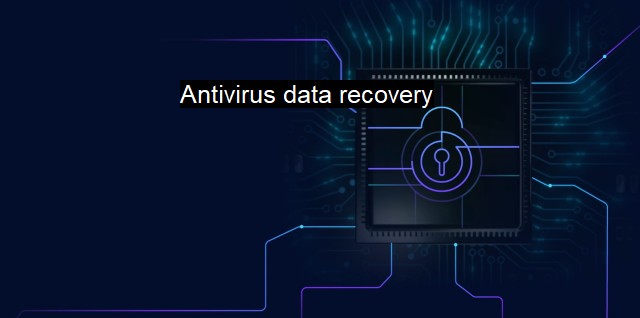What is Antivirus data recovery?
The Critical Role of Antivirus Data Recovery in Cybersecurity: Safeguarding Essential Files from Malware Attacks
Antivirus data recovery is an essential aspect within the broader realm of cybersecurity. To understand antivirus data recovery, it is crucial to appreciate the two independent yet closely related concepts — antivirus and data recovery. In short, antivirus is software that is designed to detect and eliminate harmful malware (short for malicious software), viruses, and other sophisticated threats from a computer system to ensure its smooth and secure operation. On the other hand, data recovery represents the process of retrieving inaccessible, lost, or corrupted data from digital media when it cannot be accessed in a normal way.Together, antivirus data recovery implies the use of programs or tools to restore data corrupted, altered, or lost as a result of a malicious attack, all while continuously protecting the system against any incoming cybersecurity threats.
It is the system's ability to protect data by reducing the risk posed by harmful programs and to recover data in scenarios of infections because of these malicious threats simultaneously. This, consequently, aids in upholding the integrity, confidentiality, and availability of both the information and information systems. Therefore, it is an area of considerable importance in information technology, especially considering the contemporary world riddled with technology interdependence and escalating security threats.
Moving from understanding the underlying context, let's delve a little further into why this process is of utmost significance. With the increasing reliance on computers and networks, there is simultaneously an evolution of digital dangers. Viruses, ransomware, spywares, and other cybersecurity threats not only put the system’s continuity at risk but can also lead to significant data loss. Thus, implementing an effective antivirus is no more a choice but a necessity. But even the most efficient antivirus can't guarantee absolute security. Some malignant programs can creep into the system, leading to alteration or rather corruption of data. In these circumstances, antivirus data recovery seems to be the user's last resort.
Antivirus data recovery tools come in handy in such breaches, as they follow an algorithm that extracts the corrupted or encrypted data. This is further analyzed and processed to restore in an accessible format, virtually reversing the incurred data loss. And not to misconstrue, but this goes way beyond than merely extracting encrypted data. If an effective antivirus mechanism accompanies it during the recovery procedure, it will simultaneously eliminate traces of the nefarious program. This dualistinguishing function has indubitably become an industry standard.
In practical scenarios, after a virus attack vaults one's system, the antivirus software comes into action by isolating and obliterating the virus exploiting its virus definitions. If during the attack, some files have suffered corruption or encryption, these are rendered inaccessible. Here, an antivirus data recovery tool within that antivirus software triggers data extraction and further analysis. This recovered data is made readable again in its original format, implying successful recovery. antivirus software updates its virus definitions after these invasions and makes the system less prone to suffer from similar infections in the future.
Despite the usual effectiveness of antivirus data recovery, it is important to remember that prevention has always been the best cure. Therefore, regular system scans, timely updates of the antivirus software, and effective data backup systems often prove to be more practical before invasions. Nonetheless, an effective data recovery component within antivirus software acts as that crucial plan B when all preventative measures fail.
Antivirus data recovery, as a concept, is an integral part of maintaining system health and is cardinal to the overall integrity of organizational data and functions. It has higher stakes considering the increasing risks in the current network-dependent world. Its combined essence of data protection and recovery assures reduced risk and higher reliability of information systems and reinforces the vitality of cybersecurity in the contemporary world.

Antivirus data recovery FAQs
What is antivirus data recovery?
Antivirus data recovery refers to the process of retrieving lost or deleted data from an antivirus program or an infected device.Why is antivirus data recovery important in cybersecurity?
Antivirus data recovery is important in cybersecurity because it helps to restore lost data and prevent data loss caused by malware attacks or system failures. It also assists in detecting and removing any virus or malicious software that could compromise a system's security.What are the techniques used in antivirus data recovery?
The techniques used in antivirus data recovery include forensics analysis, data carving, and file-system metadata analysis. These techniques work together to recover data that has been lost due to malware infections or other system failures.What should I do if my antivirus fails to recover my lost data?
If your antivirus program fails to recover your lost data, you should seek the assistance of a professional data recovery service. A data recovery service can help you retrieve your lost data using advanced recovery techniques and specialized equipment.| | A | | | B | | | C | | | D | | | E | | | F | | | G | | | H | | | I | | | J | | | K | | | L | | | M | |
| | N | | | O | | | P | | | Q | | | R | | | S | | | T | | | U | | | V | | | W | | | X | | | Y | | | Z | |
| | 1 | | | 2 | | | 3 | | | 4 | | | 7 | | | 8 | | |||||||